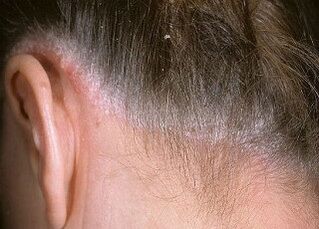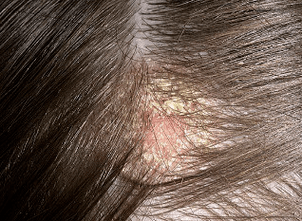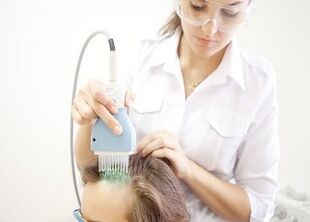
Psoriasis is a chronic disease of the upper layer of epidermal cells, which is accompanied by the presence of dead skin scales. The most common disease is psoriasis of the scalp. The disease is accompanied by large or small formations on the scalp.
Often, lesions are localized in one place. Late treatment can worsen the condition.
Diseases like these are not spread to others. Someone who suffers from the disease is safe for society.
Developmental factors of psoriasis
The main cause of skin defects is metabolic disorders.
As already mentioned, the disease is not contagious, so the patient can not endanger the health of the people around him. The presence of psoriasis in a person indicates the body's inability to respond normally to the presence of various types of stimuli. As a result, excessive cell division occurs. According to statistics, the normal process of cell division is about 30 days.
During this period, the upper layer of the epidermis is gradually replaced with a new layer. In psoriasis, excessive new cell growth can be observed, which begins to overlap with the old. The distribution period is reduced by 4 days. As a result, small scaly lesions appear on the surface of the scalp.
In most cases, it appears as mild inflammation accompanied by itching. In the process of exfoliation of the old layers of the epidermis, pink spots of various shapes form on the surface of the skin. Gradually, they begin to close with the formation of new skin cells.
Scientists have identified several causes that can also cause damage to normal metabolic functions, among them:
- Have bad habits. Alcohol abuse and excessive tobacco products cause significant changes throughout the body. If there is psoriasis on the head, the toxic substances that make up alcohol and cigarettes have a negative impact on the course of the disease.
- Power supply is incorrect. The patient's diet contains many products with large amounts of food additives and carcinogens. Poor food can be an early stage of psoriasis.
- Mechanical damage to the hairline. With recurrent injuries, dandruff may appear. Bacteria in the comb can penetrate the affected scalp, triggering disease mechanisms.
- Gastrointestinal problems.
- Unstable temperature conditions. This problem manifests itself during periods of seasonal changes in weather conditions.
- Long-term medication.
- Endocrine system failure.
- The genetic predisposition of an organism.
If there are any major signs of psoriasis on the scalp, it is recommended to seek the help of a professional dermatologist. He will choose the appropriate treatment to prevent the appearance of new wounds. Scalp psoriasis in most cases occurs in people aged 30–36 years. It is rare in young children
Symptoms
In the first stage of the psoriasis journey, the patient does not feel any change. The disease progresses slowly and without discomfort. On visual examination, in rare cases, the doctor observes the presence of dandruff in insignificant amounts. With more complex scalp psoriasis, patients experience severe itching and burning in the back of the head, forehead and ears. Plaques with dry scaly elements form in the affected area.
Microcrats begin to form on the skin, where infections enter the body. At the site of exfoliation, dry areas of the skin begin to grow rapidly. Under mechanical pressure, these plaques begin to peel off, leaving red spots. In this case, the patient needs to choose the appropriate medication to prevent the development of the disease.
Main localization location
Today, psoriasis on the head is a fairly common type of disease, which occurs in every fourth patient. Treatment that is not started early is the main reason for the spread of the disease throughout the body. The disease can occur in many forms, each accompanied by a new health problem.

The main psoriasis of the scalp is:
- skin around the ears, back of the head, behind the auricle;
- frontal lobe area, parietal area;
- posterior region of cervical spine;
- separates hair growth areas.
The disease has two forms: mild and severe.
During the early stages, the patient does not experience any unpleasant sensations. The main symptom may be persistent dandruff, which appears two days after washing. With severe forms of the disease, the patient experiences psycho-emotional discomfort, constant burning sensations and itching in the affected skin area.
Scalp psoriasis: classification and variety
Psoriasis on the head has several stages of the disease.
Dermatologists divide scalp psoriasis into the following stages:
- Startup.This is the presence of small pink papules that rise slightly above the skin. Patients may experience mild itching in the affected area. By mechanical action, small fragments of dead skin cells peel off.
- Progressive.The presence of new wounds is observed here. The patient begins to experience severe discomfort, which is accompanied by the presence of persistent itching and severe exfoliation. Papules gradually spread from each other.
- Not moving.With this stage, most of the scalp is affected by the lesion. The old area did not disappear, but, on the contrary, began to progress with greater strength.
- Regressive.Characterized by the presence of a large number of white circles in the affected area. The skin begins to dry out a lot. A large number of scaly formations are found on the surface of the papule.
Severe disease can lead to the death of hair follicles, which cause premature baldness in certain parts of the head. The scaly area gradually thickens as the skin cells die. On visual inspection, brightly colored growth was observed on the surface of the hairline. Men are exempt from military service, as moral and physical stresses cause serious illness.
Classification and variety
In medicine, there are two groups of scalp psoriasis. Each has a variety of varieties that describe all the characteristic diseases accompanied by the presence of similar symptoms. This includes the pustular type.
It includes several groups:
- general form;
- palmoplantar;
- annular.
Non-pustular types are divided into:
- the traditional form of the disease;
- psoriatic.
Each type and subgroup has similar symptoms, but different rates of disease progression. With this type of pustular disease, patients have a progressive nature of focal spread that requires good drug treatment. If there is a non-pustular type, the skin is not easily attacked by new formations.
The journey of psoriasis in childhood
In young children, early-stage scalp psoriasis is often compared to an allergic reaction - there is a slight redness on the skin surface with exfoliating elements. In most cases, the affected area is compared to diaper rash, candidiasis and eczema.
The disease develops slowly. Often the initial impetus for the appearance of blemishes on the scalp is a variety of drugs that contain aggressive components. The child must be treated under the guidance of an experienced dermatologist.
The initial stage of therapy is a strict diet. Citrus fruits, all kinds of dyes, fatty foods, carcinogens are completely not included in the diet. Medication is prescribed to prevent the spread of the affected area. Most lotions, sprays, shampoos are determined based on medical components. This therapy helps restore the hair follicles, preventing their death.
Important
Properly chosen medical measures significantly reduce the course of the disease.
For each child, a basic diet is chosen that can eliminate the spread of inflamed areas quickly. In addition to proper nutrition and medication therapy, patients are given a course of physiotherapy, which contributes to the rapid regrowth of affected epidermal cells.
How to treat psoriasis on the head in the hospital and at home
All medications for psoriasis are usually divided into two categories: external and internal. Using it, you can forget about this disease forever. As a rule, the use of external remedies is far from always possible due to the constant growth of hair, therefore, special balms and shampoos come to replace various ointments.
Not everyone knows how to treat scalp psoriasis, especially when dealing with the disease for the first time. But most internal medicine is a hormone.
In the case of drug treatment, various drugs with general enhancing effects and sedatives are often used. This can be a well-known vitamin complex, based on folic acid and niacin. Hospital treatment is done mainly in cases where psoriasis is severe or moderate. Specific treatment methods and medications are prescribed based on the stage of the disease: immobile, progressive or regressive.
At the stage when treatment at the clinic is needed, the patient no longer has time to doubt, active measures begin to eliminate inflammation and disinfect.
In addition to standard injection sets and various types of tablets, external agents, such as lotions and ointments, are used. Once the disease has progressed to the next stage - the time of regression, the patient is already out for further treatment at home. The course of treatment usually takes two weeks. And doctors should tell you how to treat psoriasis on the head at home while leaving the hospital.
Home Treatment
Until now, there is no cure that can get rid of diseases like psoriasis forever. The main goal of home treatment is primarily to control its development.
An increase in the interval of the amnesty level occurs due to the use of the following funds:
- Special shampoo.
- Healing ointment.
- Absorption of various ingredients.
- Bath with the addition of herbal injections.
- UV rays.
When prescribing treatment at home, it is important to know a few rules that must be followed:
- All prescribed medications should be taken regularly.
- If there are no obvious symptoms, it is sufficient to use products that contain aloe vera. Only in the event of a severe illness, it is necessary to switch to the use of hormone medications.
- By using the prescribed cream, you can maintain normal skin moisture levels.
- If the promise of sunbathing and recent UV therapy procedures is very important, it is very important to follow the schedule recommended by your doctor.
- To get rid of various manifestations of this disease, it is recommended to use the most common methods. A large number of doctors agree on the same opinion: it is undesirable to use several different ointments and medications at the same time, as it is impossible to determine how effective a particular medication is for you.
- Take a short break during treatment. At the same time, the average break time between courses varies from a few weeks to six months.
- If psoriasis is observed in children, then it is necessary to pay attention to the factors that provoke the disease to exclude it as soon as possible. In such cases, the diet is usually adequate.
How to cure psoriasis on the head with folk methods

You can try to cure this disease by using various folk remedies. Of course, using them alone, it is impossible to achieve amazing results, because psoriasis on the head can only be cured with complex treatments.
Folk remedies are good at helping to alleviate the condition and at the same time act as an adjunct therapy. Celandine is a plant with a base whose funds are used in cases of various infectious and inflammatory skin diseases.
It has been proven many times that in the case of psoriasis treatment can also have a positive effect on the skin. Take the simplest alcohol color of the plant and rub the scalp with it. After that, it is recommended to rinse the hair lightly with an infusion of chamomile. If discomfort occurs during the use of the product, you must stop using it. Although today there are a large number of masks, it is necessary to use them with caution in treatment, as they cause allergic reactions.
One of the most popular mask recipes, which you can make yourself, is the following: mix egg whites with a teaspoon of honey and apply the resulting mixture directly to your hair, rubbing it into your scalp with a light massaging motion. Wash the mask after 30 minutes.
Various oil-based masks are quite effective. You can take essential oils such as rosemary or tea tree and add a teaspoon of almonds / coconut into it. The resulting mixture must be rubbed on the hair and kept for at least two hours. You need to clean such a mask with a special therapy shampoo.
Keep in mind that you should clean your hair more than once. Onion compresses are often used to fight the disease. They are very easy to do. Just need to cut a small piece of fruit into a porridge and apply directly to the scalp with a massaging motion. Such compresses are cleaned after two hours.
For maximum effect, this procedure must be repeated at least three times a week. The drug has only one, but a rather serious drawback, namely a strong odor, which is unlikely to be removed on the same day when the compress is applied.
Therapy Diet
One of the most important conditions for the effective treatment of psoriasis is adherence to a specially formulated diet.
The point lies in the exclusion of certain foods from the diet:
- Coffee.
- Various citrus fruits.
- Alcoholic beverages.
- Fruits, vegetables, but only red.
- Carbonated drinks.
- Spicy food.
- Any sweets that contain chocolate.
- Products that contain any food coloring or seasoning or preservative.
Also, to adhere to a strict diet, it is necessary to minimize the intake of eggs and sugar in any form. Once the symptoms are partially gone, the use of food from the forbidden list can be eaten again. However, you need to monitor the reaction of what the body will do. Once symptoms reappear, the product should be eliminated from your diet.
Hair care rules
Brush your hair gently and only after it is completely dry. After washing the hair, rinse with boiled water with lemon juice. If there are a lot of plaques on the head, you can use soap every two months to wash the hair.























